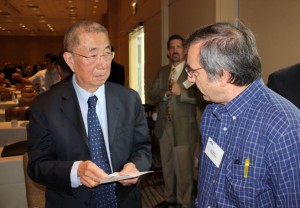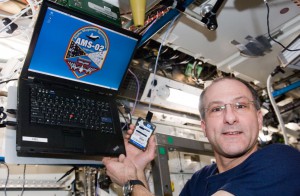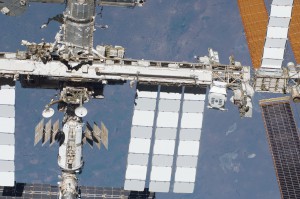In today’s A Lab Aloft our guest blogger is Trent Martin, the NASA project manager for the Alpha Magnetic Spectrometer instrument. Martin shares the challenges and excitement of seeking to unravel the mysteries of the universe.
Can a single data point make a difference? When speaking of the collected billions of data points since the inception of the Alpha Magnetic Spectrometer-02 (AMS-02) to the International Space Station (ISS), the answer is yes. Every data point leads us closer to unveiling the answers to the questions of the universe.
A handful of those unique data points were the topic of the keynote speech delivered by AMS principal investigator Professor Samuel Ting at this year’s ISS Research and Development Conference in Chicago. Approximately 90 percent of the universe is not visible and is called dark matter. Collisions of “ordinary” cosmic rays produce positrons. Collisions of dark matter will produce additional positrons. This excess of positrons has been seen in the AMS data. While more data is needed, this specific handful of points tells us something we didn’t know before about our universe. It adds to our current knowledge and guides us on our path to answers in the areas of dark matter and more.

In May, 2011 as the space shuttle Endeavor sat on the pad ready to launch the AMS-02 to the space station, it carried the hopes and dreams of 600 physicists, engineers and technicians from 60 institutes in 16 countries who had worked for nearly 1.5 decades to build the most sophisticated magnetic spectrometer ever to be put into space. Led by Ting, a Nobel Laureate from the Massachusetts Institute of Technology, the detector is designed to cull through galactic cosmic rays searching for the origins of the universe, evidence of dark matter, evidence of naturally occurring anti-matter and other cosmic phenomena.
In the words of Ting, “the most exciting objective of AMS is to probe the unknown; to search for phenomena which exist in nature that we have not yet imagined nor had the tools to discover.” AMS-02 provides that set of tools.

It is exciting to have the chance to continue to collect data to close the gap on these types of questions. The AMS-02 will run aboard station for the next decade—a timeline granted by the station extension to 2024, but also thanks to a design change just prior to the launch to the space station. This was at the time of an earlier station extension to 2020, at which point the original cryogenic magnet was swapped for a permanent magnet. Had we kept the original magnet, the AMS-02’s life expectancy for operations on orbit would already be at a close—and we’d be left with questions unanswered. Instead, the final selection of a permanent magnet enabled our continued quest towards discovery today.
Let’s take a closer look at how AMS-02 works to help us seek those answers. If you asked a high-energy experimental physicist to provide a wish list of every instrument they would like to see on some theoretical detector, they would likely provide a list that is identical to the six instruments that make up the AMS-02. Since the detectors are so complex and include over 300,000 data channels, providing for easily replaceable systems in space was nearly impossible. Instead, the systems were designed and built with a significant amount of redundancy. Multiple detectors measure charge, momentum, and energy of a passing particle. Although each detector measures in a different way, it provides us redundant and confirming measurements. The electronics for the detectors are also redundant. In most cases, the electronic systems have four-fold redundancy. This makes for a reasonably secure fail-safe, most would agree.
Operations on the station began within hours of the AMS-02 installation on the S3 truss. Since May 2011, there has been very little time when AMS-02 was not collecting data. The amount of information has been somewhat unexpected. AMS-02 has measured more than 52,000,000,000 particles. In fact, we measure at a rate of 16,000,000,000 particles per year. We were expecting more like 11 billion particles per year. This improved rate of return means more data points in each communication for ground teams to analyze.
In addition to the external instrument, which is the largest payload aboard station, the AMS-02 employs a laptop that is dedicated to the instrument’s operations from the interior of the orbiting laboratory. This internal system acts as a crew interface to AMS-02 and provides a backup system in the event of a long-term loss of data from the space station to the ground. This is an important capability for our search for antimatter because it only takes one of the billions of events to see an antimatter particle.

The search for anti-matter is actually quite challenging. I think of it like this, during the spring in Houston, there are many rain showers. If we assume it is a very rainy day in the large city of Houston, it would be like someone asking you to look at all of those clear rain drops and find one drop that is colored red! As we look at the billions of data points, we are seeking a drop in a rainstorm of information.

The AMS-02 science data points are stored on NASA computers as soon as the information reaches the ground at the Marshall Space Flight Center in Huntsville, Alabama. It is stored again as soon as it reaches Geneva. Teams of scientists work daily to analyze the data coming from the AMS-02. Typically these teams are broken into two groups to ensure that the analysis is independently analyzed. The teams meet about once per month to go through their results, work on papers, and identify new areas of interest. AMS-02 publications can be found here.
Thanks to the extremely high data rate and the precision of the AMS-02 detectors, the data is providing significantly improved tolerance bands on the measured data when compared to other detectors. In the past hundred years, measurements of charged cosmic rays by balloons and satellites have typically contained approximately 30 percent uncertainty. AMS-02 will provide cosmic ray information with closer to one percent uncertainty.

There is a lot of excitement that surrounds the findings from this instrument. The first paper published by AMS-02 was published in Physical Review Letters. The paper was highlighted in a Viewpoint appearing in the April 2013 issue of Physics. Being chosen for Viewpoint is a very selective process. According to the editor in chief of American Physical Society, “The APS published a total of about 18,000 articles last year, but only around 100 Viewpoints will appear each year. This places your paper in an elite subset of our very best papers.”
Based on the data coming from AMS-02, the space station has become a unique platform for precision physics research. During this orbiting laboratory’s lifetime, we expect to obtain 300 billion events. It is my hope and belief that somewhere buried in those 300 billion events we will find a better understanding of the origins of the universe.

Trent Martin is currently the associate director of engineering for advanced development at NASA’s Johnson Space Center in Houston, in addition to serving as the AMS NASA project manager. Martin has a bachelor’s degree in Aerospace Engineering from the University of Texas and an MBA from the University of Houston at Clear Lake. He has worked at Johnson since 1995.
